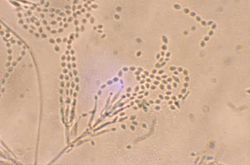| Purpureocillium | |
|---|---|
 | |
| Divergent phialides and long, tangled chains of elliptical conidia borne from more complex fruiting structures characteristic of Purpureocillium lilacinum; magnification 460X. | |
| Scientific classification | |
| Domain: | Eukaryota |
| Kingdom: | Fungi |
| Division: | Ascomycota |
| Class: | Sordariomycetes |
| Order: | Hypocreales |
| Family: | Ophiocordycipitaceae |
| Genus: | Purpureocillium Luangsa-ard, Hywel-Jones, Houbraken & Samson (2011) |
| Type species | |
| Purpureocillium lilacinum (Thom) Luangsa-ard, Hou- braken, Hywel-Jones & Samson (2011) | |
| Synonyms [1] | |
PaecilliumLuangsa-ard, Hywel-Jones & Samson nom. prov. (2007) [2] | |
Purpureocillium is a fungal genus in the Ophiocordycipitaceae family. The genus now contains at least 5 species with the type species Purpureocillium lilacinum, a common soil mold. [3] It has been isolated from a wide range of habitats, including cultivated and uncultivated soils, forests, grassland, deserts, estuarine sediments and sewage sludge, and insects. It has also been found in nematode eggs, and occasionally from females of root-knot and cyst nematodes. In addition, it has frequently been detected in the rhizosphere of many crops. The species can grow at a wide range of temperatures – from 8 to 38 °C (46 to 100 °F) for a few isolates, with optimal growth in the range 26 to 30 °C (79 to 86 °F). It also has a wide pH tolerance and can grow on a variety of substrates. [4] [5] P. lilacinum has shown promising results for use as a biocontrol agent to control the growth of destructive root-knot nematodes.
